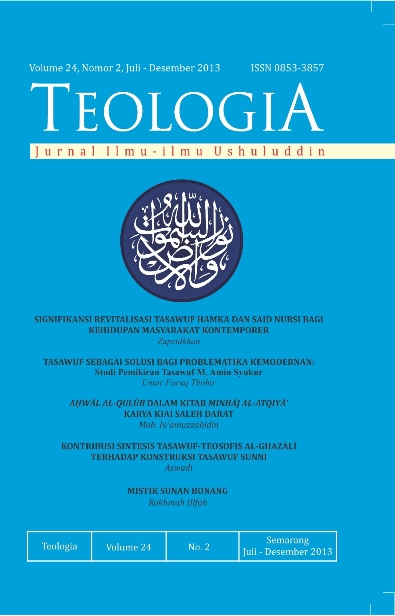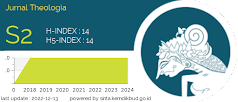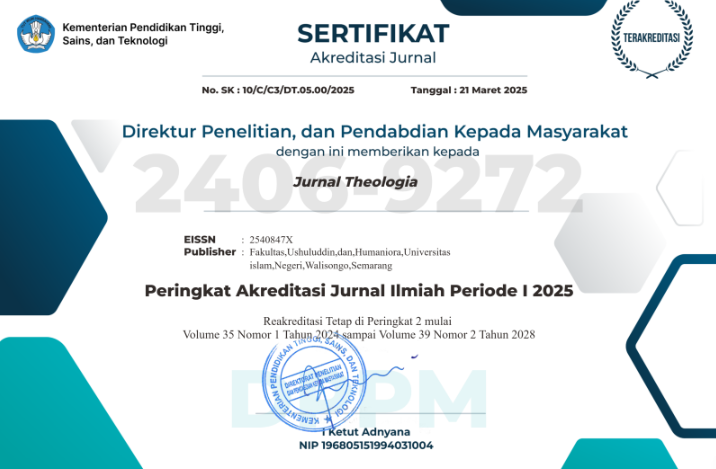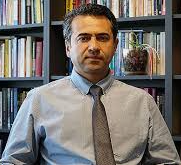KONTRIBUSI SINTESIS TASAWUF-TEOSOFIS AL-GHAZĀLĪ TERHADAP KONSTRUKSI TASAWUF SUNNI
DOI:
https://doi.org/10.21580/teo.2013.24.2.329Abstract
Abstract: Sufism of al-Ghazālī patterned the osophist, an integration between the theological and philosophical Sufism. The dominance pattern of the osophical Sufism of al-Ghazālī emphasizes the mystical experience is spread through philosophical reasoning. The his study method departed from the truth of faith and test it through mystical experience method. The peak of his Sufism leads to various dimensions, and then described through the frame work of rational thinking. According to al-Ghazālī, the essential Ma'rifat to be obtained through inspiration or nūr who Allah enter into the hearts of people to recognize the nature of God and all His creation. The knowledge is obtained from ma'rifat more true than the knowledge is acquired by the reason. Abstrak: Tasawuf al-Ghazālī bercorak teosofis, merupakan integrasi antara tasawuf teologis dan filosofis. Dominasi corak tasawuf teosofisal-Ghazālī lebih mengedepankan pengalaman sufistik yang dibentangkan melalui penalaran filosofis. Metode kajiannya berangkat dari kebenaran iman dan mengujinya melalui metode pengalaman sufistik. Puncak tasawufnya bermuara pada tataran ma’rifat dengan berbagai dimensinya, kemudian diuraikan melalui kerangka berpikir rasional. Ma’rifat yang hakiki menurut al-Ghazālī diperoleh melalui ilham atau nūr yang dicampakkan Allah ke dalam qalb manusia untuk mengenali hakikat Allah dan segala ciptaan-Nya. Ilmu yang diperoleh dari ma’rifat lebih benar daripada ilmu yang diperoleh melalui akal. Keywords: ma’rifat, qalb, teosofis, filosofis, gnostik.Downloads
References
Aberry, A.J., Sufism: an Account of The Mystics of Islam, London: Unwin Paperbacks, 1979.
Ahmad, Zainal Abidin,Riwayat Hidup al-Ghazali, Jakarta: Bulan Bintang, 1975.
Asmaran As, Pengantar Studi Tasawuf, Jakarta: Grafindo Persada, 1994.
Atjeh, Abu Bakar,Pengantar Ilmu Tarekat: Uraian tentang Mistik, Solo: Ramadlani, 1990.
Basyūnī, Ibrāhīm, Nasy’at Taṣawwuf al-Islāmī, Kairo: Dār al-Fikr, 1969.
Dauly, Ahmad, Kuliah Filsafat Islam, Jakarta: Bulan Bintang, 1989.
Ghazālī, Abū Ḥāmid Muḥammad bin Muḥammad, Iḥyā’ Ulūm al-Dīn, Juz I-IV, Semarang: Thaha Putra, tth.
Ghazālī, Abū Ḥāmid Muḥammad Ibn Muḥammad, Mukhtaṣar Iḥya’ Ulūm al-Dīn, Beirut: Dār al-Fikr, 1993.
Ghazālī, Abū Ḥāmid Muḥammad Ibn Muḥammad,al-Munqiẓ min al-Ḍalāl, diedit oleh Muḥammad Muṣṭafā Abū A’la, Beirut: al Maktabah al-Sya’biyah, tth.
Ghazālī, Abū Ḥāmid Muḥammad Ibn Muḥammad, Mukāsyafāh al-Qulūb al Muqarrab min al-‘Alam al Ghuyūb, Kairo: Dār al-Sya’b, tth.
Gibb, H.A.R. dan J.R. Kramers, Shorter Encyclopedia of Islam, London: Lucas Luzac Co. 1961.
Iḥsan Muḥammad Daḥlan, Sirāj al-Ṭālibīn Syarḥ atas kitab Minhaj al-‘Ᾱbidīn ilā Jannati Rabb al-‘Ᾱlamīn, Juz II, Mesir: Musṭafā al-Bābi al Ḥalabī, 1955, h. 209
Lewis, Bernard,dkk., The Encyclopedia of Islam, Vol. II, London: Lucas dan Co. 1965.
Madjid, Nurcholis(ed.), Khazanah Intelektual Islam, Jakarta: Bulan Bintang, 1985.
Maḥmūd, Abd al-Ḥalīm, Qadiyat al-Taṣawwuf al-Munqiẓ min al-Ḍalāl, tt: Dār Ma’ārif, 1988.
Mubārak, Zakiy, al-Akhlāq ‘Inda al-Ghazāli, Kairo: Dār al-Kutub al-’Arabi, 1924.
Nasution, Harun, Falsafah dan Mistisisme dalam Islam, Jakarta: Bulan Bintang, 1992.
Nasution, Harun, Islam Ditinjau dari Berbagai Aspeknya, Jil. II, Jakarta: UI Press, 1986.
Nasution, Harun, Islam Rasional: Gagasan dan Pemikiran, Bandung: Mizan, 1995.
Qusyairī, Abū al Qāsim Abd al-Karīm bin Hanafis bin Hawāzin, al-Risālah al-Qusyairiyah fī ‘Ilm al-Taṣawwuf, di-taḥqīq oleh Ma’ruf Zariq dkk, ttp: Dār al Khair.
Rahman, Fazlur, Islam, terj. Senoaji, Jakarta: Bumi Aksara, 1992.
Subki, Ṭarīqat al-Syāfi’iyah, Juz IV, Mesir: Muṣṭafā al-Bābī al Halābī, tth.
Sulaimān, Fathiyah Ḥasan, Mażāhib fī al-Tarbiyah Baḥṡ fī al-Mażhab al-Tarbawi ‘Inda al-Ghazālī, Mesir: Maktabah Nahḍah, 1964.
Syarif, M. (ed.), Para Filosof Islam, Bandung: Mizan 1989.
Ṭibānah, Badawi Ahmad, Muqaddimah al-Ghazālī wa Iḥyā’ ‘Ulūm al-Dīn, Juz I, Semarang: Thaha Putra. tth, h. 8.
Watt, W. Montgemery, Pemikiran Teologi dan Filsafat Islam, terj. Umar Basalim, Jakarta: P3M. 1987.
Yafi, Ali, “Syariah, Thariqah, Haqiqah dan Ma’rifat”, dalam Budi Munawar-Rachman (ed.), Kontekstualisasi Doktrin Islam dalam Sejarah, Jakarta: Paramadina, 1995.





















